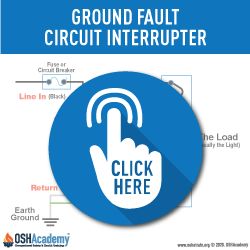Controlling Electrical Hazards
Secondary Protective Measures
Secondary protective measures are essential in healthcare settings to safeguard against electrical hazards when primary protections fail.
Ground-Fault Circuit Interrupters
Secondary protective strategies used in healthcare include the use of Ground-Fault Circuit Interrupters (GFCIs) and grounding systems.
Ground-Fault Circuit Interrupters (GFCIs) are fast-acting circuit breaker devices designed to interrupt (shut off) electric power within 1/40 of a second when they detect short-circuit ground faults on 120-volt 15- and 20-ampere receptacles. They are commonly installed in patient care areas, operating rooms, and near sinks to cut off power instantly if a fault is detected.
Grounding and Bonding Systems
Grounding systems provide a path for electrical current to safely dissipate into the earth, preventing electrical shocks, equipment malfunctions, and fire hazards.
Grounding connects an electrical system to the earth using wires called Grounding Electrode Conductors (GECs) and materials like metal rods.
Grounding and Bonding
Grounding creates a safe path for electricity to flow in case something goes wrong, such as a lightning strike or a fault in the system. They reduce the risk of shocks from faulty equipment or power surges, especially critical in areas with life-support and diagnostic devices.
Bonding is different from grounding. It connects metal parts of the electrical system that don't normally carry electricity, such as the metal cases of appliances, using wires called Equipment Grounding Conductors (EGCs) or bonding jumpers. Bonding ensures that all these parts have the same electrical charge, preventing shocks if you touch two metal parts at the same time.
If a live wire (one carrying electricity) accidentally touches a metal part, bonding provides a safe path for the electricity to flow back to the circuit breaker panel. This creates a high current that causes the breaker to trip or a fuse to blow, shutting off the power and stopping the danger. This greatly reduces the risk of electric shock.
- Using isolated power systems (IPS) ensure uninterrupted power by isolating the system from the ground. They are used in operating rooms and intensive care units.
- Including grounding equipment connections for medical devices like X-ray machines, MRI scanners, or infusion pumps to prevent shocks in case of insulation failures.
- Installing grounding mats or straps in areas prone to static electricity like laboratories and clean rooms.
- Using electrical shielding in MRI and CT scan rooms to prevent interference from external electromagnetic fields that can affect accuracy.
- Installing conductive flooring and grounded surgical tables to dissipate static electricity, reducing fire risk when oxygen and flammable anesthetics are used.
Knowledge Check Choose the best answer for the question.
1-3. What are fast-acting circuit breaker devices designed to interrupt (shut off) electric power within 1/40 of a second?
You forgot to answer the question!

